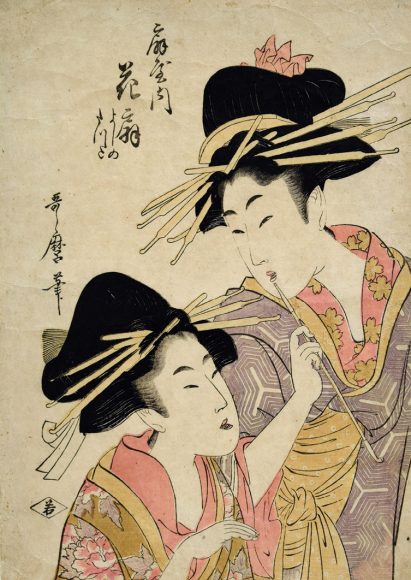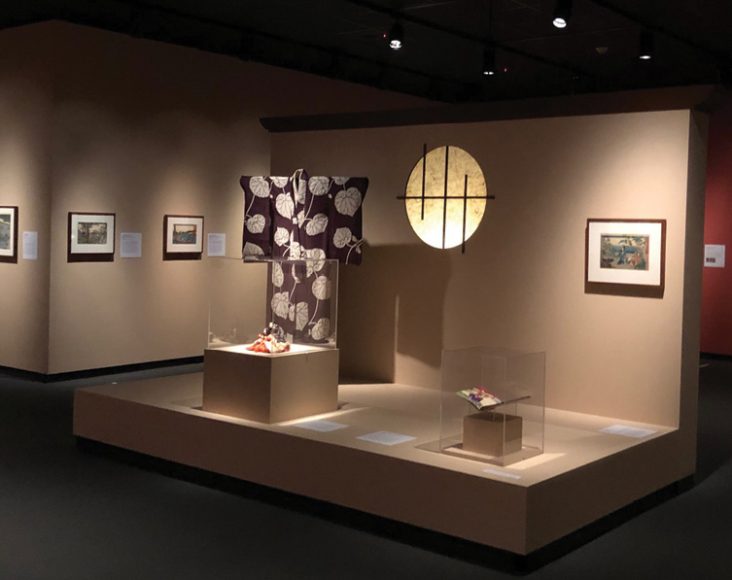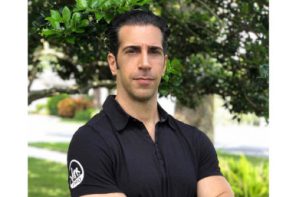“Floating Beauty: Women in the Art of Ukiyo-e,” at the Bruce Museum in Greenwich through Nov. 1, is a timely exhibit times two.
In a year in which we’re celebrating the centennial of American women’s suffrage, “Floating Beauty” offers a window onto the peculiar yet not unfamiliar treatment of women during four centuries of Japanese history. But in its portrayal of a world that was centered on arts and entertainment, it also holds up a distant mirror to our own culture, in which the coronavirus has remade our notions of leisure and life’s impermanence.
The exhibit features 40 color woodblock prints from the permanent collection of Pennsylvania’s Reading Public Museum that were made during Japan’s critical Edo period (1615-1868), which began with the military rule of the shogun Tokugawa Ieyasu and ended after the reopening of Japan to the West. (It was called the Edo period after Ieyasu’s capital, now Tokyo.)
Ieyasu reorganized Japanese society into a strict caste system of (in descending order) samurai, farmers, artisans and merchants that was based on neo-Confucian morality. To quell the inevitable resentment of the lower classes toward the aristocrats, who managed to slip through many of the rules, the shogun established the Yoshiwara pleasure district that embraced everything from courtesans to kabuki theater. Soon artists like Kitagawa Utamaro, Katsushika Hokusai and Utagawa (Ando) Hiroshige I were creating “pictures of the floating world” (ukiyo-e) of leisure, in particular those of beautiful women (bijinga). These prints would have a profound effect on the French Impressionists and Postimpressionists when they were exhibited in Paris at L’École des Beaux Arts in 1890.
It’s easy to understand why everyone from Mary Cassatt to Vincent van Gogh was bowled over. The prints — made through a painstaking, multilayered process for the masses — presented a vibrantly colored, detailed view of nature as well as Japanese society. The exhibit includes Hokusai’s seminal “The Great Wave off the Coast of Kanagawa” (1830-31, ink on paper), a masterwork of blues, grays and whites in which a mammoth wave dwarfs Mount Fuji in the backdrop and two long boats, whose huddling crews struggle to stay afloat in the foreground. But amid works on nature like the dramatic “Great Wave” and Hiroshige’s serene scene of fishermen (“Village by the Tamagawa River,” 1858, ink on paper), there are those that paint a darker portrait of Japanese society and the roles of women in it.
The exhibit text notes that women enjoyed a certain status, autonomy and influence before the arrival of a harsh form of Chinese Buddhism and Confucianism that depicted women as inherently evil and stupid, confining them to being utterly obedient housewives and mothers or courtesans and laborers. (Interestingly, high-born ladies and courtesans alike tied the sashes of their kimonos in the front to indicate they did not have to do manual labor, while laboring women tied theirs in the back so they would not interfere with their work.) A woman might run a teashop or a brothel or become a hairdresser or even an artist, but these were exceptions that proved the rules.
Standards of beauty were just as rigidly defined — lead-based makeup to whiten the skin, plucked eyebrows painted higher on the face, teeth blackened by an iron-based drink and a wooden headrest to maintain the required elaborate coiffure. There is, noted an artist friend of ours who accompanied us to the exhibit, a certain sameness to the elongated, expressionless faces with their aquiline noses, small mouths and slit eyes and brows — with the exception of one print depicting women with soft, round features that may or may not have been created by a female artist.
“What we’re seeing is a male gaze, presented from a male viewpoint,” says Corinne Flax, manager of school and community partnerships at the Bruce, who does a lot of educational outreach on its shows.
Indeed, in a section on kabuki theater’s female impersonators the text notes the prevailing wisdom of the day about that gaze — that only a man could portray a woman since only a man could observe one from the outside. Apparently, the best woman, then, was a man.
Such observations are not limited to the Japanese society of yesteryear. The male gaze has been the default throughout the history of the arts. wagmag.com/the-eyes-have-it-2/ And, Flax adds, instead of blackening their teeth and shaving and painting their eyebrows, women today are whitening their teeth and microblading their brows.
Similarly, the fleeting aspect of entertainment that was the subject of the ukiyo-e prints is all around us nowadays, particularly in this age of the coronavirus.
“How much of my modern life is the pursuit of pleasure or taking in pleasures you’re not aware of?” Flax asks, noting the giant information screens around New York City that you can plug your phone into and that have replaced the old phone booths. “All of our world is a bit of a floating world.”
And yet the irony is that while the world that inspired these prints is long gone, the works themselves are still with us, conjuring the past.
Life is short. Art remains.
For more, visit brucemuseum.org.






